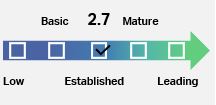
The IATA Operational Safety Audit (IOSA) is a global industry standard for airline operational safety auditing. For two decades, IOSA has become the industry benchmark in safety auditing, contributing to improving safety performance and providing extensive cost-saving measures for IOSA participating airlines. The program is a condition for IATA membership.
To keep up with today’s dynamic environment, the IOSA Program has shifted to a risk-based approach. Focusing on pertinent safety risks, while maintaining a baseline of safety, the current IOSA Program increases the effectiveness of the audit and contributes to the overall industry goal of reducing the accident rate.
Additionally, IATA continually develops the IOSA Standards and Recommended Practices (ISARPs), in cooperation with industry partners.
Features of the Risk-Based Approach
Audit scoping is based on a combination of industry standards and operator-specific elements such as operational profile, safety events, and the operator's IOSA audit history.
The below example illustrates how different factors will be considered in the audit scoping and how this practice differs from today's process.
Example of audit scoping under a risk-based approach to IOSA
| Audit Scoping | Previously | Today - Risk-based approach |
|---|---|---|
|
|
|
|
|
|
Maturity Assessment
The maturity assessment introduces a more structured and comprehensive way of providing the airline with an evaluation of its relevant safety systems and programs. This further assists in determining the next steps in improving its operational safety.
In addition to the introduction of the maturity assessment, Risk-based IOSA continues to require a baseline of conformity with IOSA Standards and Recommended Practices (ISARPs). The example below shows the difference between the conventional conformity assessment and the maturity assessment that has been introduced.
Example of maturity assessment under a risk-based approach to IOSA
| Maturity assessment | Previously | Today - Risk-based approach |
|---|---|---|
|
FLT 2.2.14 "The Operator shall ensure flight crew members compete Operator familiarization training prior..." |
Assessment Method (on each ISARP) Conformity Nonconformity |
Assessment Method (on selected ISARPs and Programs)
|
IOSA Registry
Check out the IOSA Registry with over 450 registered airlines on the IATA Connect platform.
IOSA Documentation
Find all the documentation related to the implementation and renewal of your IOSA audit.
